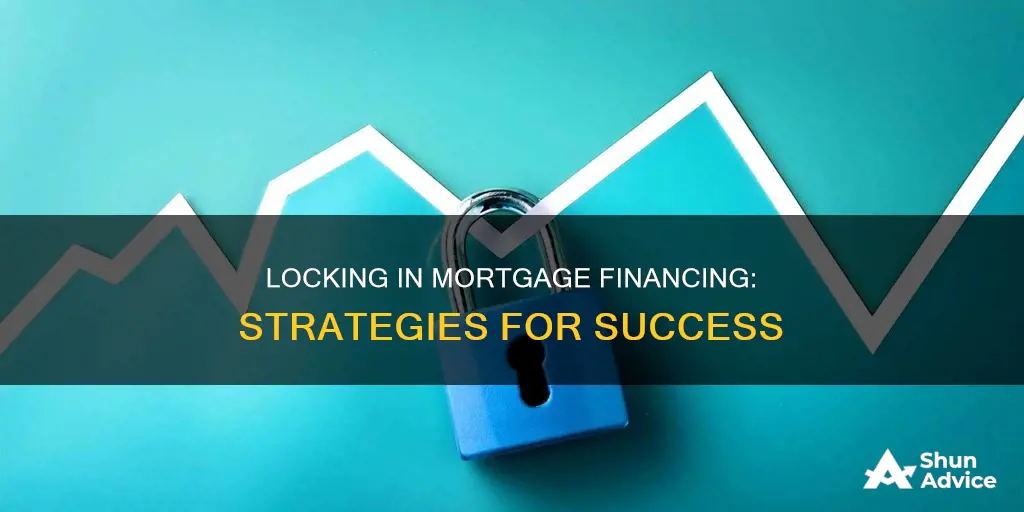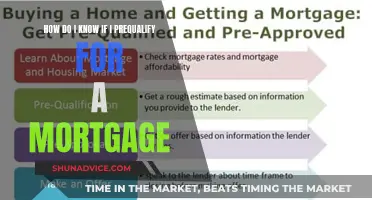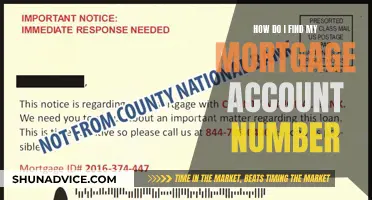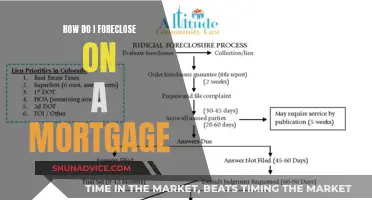
Locking in a mortgage rate is a way to secure your interest rate as you shop for a home. It is an offer by a lender to guarantee the interest rate of your loan for a specified period of time. This is important because mortgage interest rates can change daily, sometimes hourly, and can be influenced by the housing market and demand, the economy, and your personal situation. The time to lock in the mortgage rate is after you've shopped lenders and are approved for a home loan. It is advisable to have a thorough discussion with your loan officer, as they can provide insights and monitor market trends to help you make an informed choice.
| Characteristics | Values |
|---|---|
| What is a mortgage rate lock? | A mortgage rate lock is an offer by a lender to guarantee the interest rate of your loan for a specified period of time. |
| When to lock in a mortgage rate | There is no universal time to lock in a mortgage rate. It depends on the market, your financial situation and your risk tolerance. |
| How to lock in a mortgage rate | You can lock in a mortgage rate by creating an account, researching current interest rates and monthly payments, applying for the type of financing you want, and locking in your interest rate online. |
| Rate lock period | The rate lock period usually extends from initial loan approval to loan closing. It can be 30, 45 or 60 days, or sometimes longer. |
| Rate lock cost | Rate locks are not free. The lender may charge an extra fee or include the cost of the rate lock in the loan. |
| Float-down option | Some lenders offer a float-down lock, which allows you to take advantage of lower rates if they become available before you close the loan. |
What You'll Learn

When to lock in a mortgage rate
Locking in a mortgage rate is a way to secure your interest rate as you shop for a home or refinance an existing one. It keeps your mortgage interest rate from fluctuating and protects you from higher rates. The time to lock in a mortgage rate is after you have shopped lenders and are approved for a home loan.
Mortgage interest rates can change daily, sometimes hourly. They are intricately tied to the broader economic conditions and the Federal Reserve's monetary policies. When the economy is strong and healthy, interest rates tend to rise. When the economy slows, the demand for mortgages also slows, and mortgage rates typically drop.
There is no universal time to lock in a rate. It depends on the market when you buy, your risk tolerance, and your financial situation. Some people are more comfortable locking in early on, while others prefer to gamble on fluctuations. One sensible rule of thumb is to lock in your rate when there's a scenario that works within your needs and budget. You need to assess how much risk you're comfortable with and go from there.
Before locking in a mortgage rate, it's advisable to have a thorough discussion with your loan officer, as they can provide insights and monitor market trends to help you make an informed choice. They will ask you a few questions about your income, debt, and assets. You can also research current interest rates and estimate monthly mortgage payments using a mortgage calculator.
Once you are satisfied with your chosen mortgage solution, you can proceed with the mortgage application process for the specific financing option you desire. After verifying your financial records and reviewing your application, your lender can quote you a rate and any fees to lock it. If everything looks good, you can submit a request to lock in the rate.
Accessing Your Mortgage Statement: A Quick Guide
You may want to see also

How to lock in a mortgage rate
Locking in a mortgage rate is a way to protect yourself from market fluctuations. Mortgage interest rates can change daily, and even hourly, so a rate lock can save you thousands of dollars over the course of a loan.
A mortgage rate lock is when a lender guarantees the interest rate of your loan for a specified period of time. This period usually extends from the initial loan approval, through processing and underwriting, to loan closing. The rate lock ensures that the interest rate won't change, no matter what happens in the economy, unless there are changes to your application details.
The length of the lock period depends on your specific situation and can vary from 30, 45, 60 days or more, and sometimes longer. Construction loans tend to have longer lock periods, such as 12 months. It is important to ensure that the rate lock agreement covers the time until you close the loan. It may be expensive to extend the lock period, and it may also lock you out of a lower interest rate if rates fall after you get your loan offer.
The right moment to lock your mortgage rate can be tricky to determine, so it is advisable to discuss this thoroughly with your loan officer, who can provide insights and monitor market trends. You can also research current interest rates and potential monthly payments using a mortgage calculator. Once you are satisfied with your chosen mortgage solution, you can proceed with the mortgage application process.
Who Holds Your Mortgage? Understanding Your Mortgage Servicer
You may want to see also

What is a float-down policy?
A float-down policy is a financing option that allows borrowers to lock in their interest rate on a mortgage while retaining the flexibility to reduce it if market rates fall during the lock period. This policy is particularly useful when there is uncertainty in the financial markets, and interest rates are expected to fall before closing a deal.
The float-down option is offered by lenders to retain borrowers and prevent them from taking their business elsewhere. While it provides borrowers with the security of a fixed rate, it also allows them to take advantage of improved interest rates during the mortgage application process. This option is not automatically provided, and borrowers must explicitly ask for it.
The float-down agreement comes at a cost, with borrowers paying a fee for the flexibility it offers. This fee can range from a few to several hundred dollars, depending on the lender. It is important to note that even with the float-down option, borrowers are not guaranteed a lower rate. Lenders have rules and criteria regarding how and when borrowers can exercise the option to float the rate down.
To determine the right moment to lock in a mortgage rate, borrowers should consult their loan officers, who can provide insights and monitor market trends to help make an informed decision.
Freddie Mac: Who Owns Your Mortgage and How to Know?
You may want to see also

How to avoid rate lock fees
A rate lock on a mortgage loan means that your interest rate won't change between the offer and closing, as long as you close within the specified time frame and there are no changes to your application. Rate locks typically last from 30 to 60 days, but some lenders will extend a rate lock for 120 days or more. Certain lenders may offer a free rate lock for a specified amount of time but then charge fees for extending the lock.
- Understand your lender's rate lock policy: Before locking your rate, confirm your lender's policy. Ask about the cost, timelines, and get a copy of the fine print. Some lenders offer a "'float-down' option, which allows you to get a lower rate if prevailing rates fall after you initially lock.
- Shop around for lenders: Rate lock options and fees can vary widely among lenders. Ask each lender you consider about their rate lock periods and any fees to extend them.
- Choose a longer rate lock period: If you are concerned about your rate lock period being too short, ask your lender about switching to a longer rate lock period. Most lenders offer complimentary rate locks for 30 to 60 days, but you may need a longer period to avoid extension fees.
- Negotiate for the seller to pay for the extension: If the delay is caused by the seller, you can often negotiate for them to pay for any extension or other costs incurred by the delay.
- Change lenders and apply for a new loan: You can apply for a new loan with a different lender, which will quote you a new rate based on the current market. You can then start a new 30- or 60-day rate lock for no fee. However, this option can delay your home purchase further and may only be worth it if the potential savings are high.
- Keep on top of your mortgage application: Regularly communicate with your lender to avoid unexpected fees and ensure you understand the costs and timelines involved.
Keep Your Mortgage Steady: Tips to Avoid Rising Costs
You may want to see also

How to get the best rate lock
A mortgage rate lock is an agreement between a borrower and a lender that allows the borrower to lock in the interest rate on a mortgage for a specified time period at the prevailing market interest rate. The rate lock ensures that the borrower's mortgage interest rate is kept from fluctuating and is protected from rising during the lock period. The lock period usually extends from the initial loan approval to the loan closing.
- Do your research: Understand how mortgage payments work and what they are made of. Your mortgage payment includes repayment of the home and interest, taxes, and insurance. Research the current interest rates and potential monthly payments by using a mortgage calculator. This will help you determine how much you can afford and what type of mortgage is best for you.
- Monitor market trends: Mortgage interest rates fluctuate constantly depending on the market. Keep an eye on the overall economic health of the nation, as well as the Federal Reserve's monetary policies. When the demand for mortgages is high, rates tend to climb, and when demand slows, rates tend to drop.
- Discuss with your loan officer: Have a thorough discussion with your loan officer, who can provide insights and help you monitor market trends. They will ask you questions about your income, debt, and assets to help you find the best mortgage solution for your financial goals.
- Consider the timing: Determining the right moment to lock your mortgage rate can be tricky. Consider the current interest market rate trends and your financial situation to decide if a mortgage rate lock is right for you. If interest rates are falling or are generally low, skipping a rate lock may be a good strategy.
- Understand the rate lock agreement: Ask your lender about the details of the rate lock agreement, including the lock period, any fees associated with the lock, and the potential for a "float down" option, which allows you to take advantage of lower rates. Make sure the lock period is long enough to cover the time until you close on your loan.
Understanding Your Mortgage Grace Period: What You Need to Know
You may want to see also
Frequently asked questions
A mortgage rate lock is an offer by a lender to guarantee the interest rate of your loan for a specified period of time. This period usually extends from initial loan approval to loan closing.
To lock in your mortgage financing, you must first submit a request to your lender. You can do this online using a platform such as Rocket Mortgage. Before submitting your request, you should research current interest rates and estimate monthly mortgage payments using a mortgage calculator. Once you are happy with the rate on offer, you can lock it in.
Rate locks are not free. The lender may charge an extra fee or include the cost of the rate lock in the loan. This fee is typically a quarter to half a percent of the loan amount.
There is no universal time to lock in a mortgage rate. It depends on your risk tolerance, the market, and your financial situation. If rates have been rising, it may be best to lock in your rate as soon as your mortgage or refinance is approved. If rates are dropping, you may prefer to gamble on further fluctuations.
A float-down lock is a type of rate lock designed to help you take advantage of lower rates if they become available before you close the loan. You will generally pay a fee for this option, so you need to make sure the potential savings are worth the expense.







